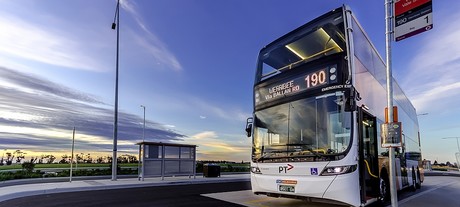Buses boosted by improved comms

ComfortDelGro Cabcharge has made a significant investment in digital voice and data infrastructure to ensure better safety and operational efficiencies.
ComfortDelGro Cabcharge (CDC) is one of the largest private bus operators in Australia, with a fleet of 1900 vehicles covering the Hunter Valley, Sydney, Canberra, Melbourne and Ballarat. Following the opening of a new operations and customer centre (OCC) in Sydney, CDC required a new communications infrastructure that would enhance customer experience, improve security on buses and create further efficiencies in service delivery.
That solution was the Orion Network, Australia’s largest digital commercial two-way radio platform, powered by Motorola Solutions’ MOTOTRBO Connect Plus DMR technology. The network facilitates integrated digital voice and data communications between the OCC, depots and drivers. The upgrade also included MOTOTRBO two-way radios and TRBOnet, a fleet management application designed specifically to support dispatch centre operations, with direct access to the Orion Network via Motorola Solutions XRT9000 voice and data gateways.
The solution has provided a range of benefits and improvements for the organisation.
Improved driver safety. Installation of a custom duress function enables drivers to call for help and instigates an automated email broadcast (which includes the bus location map) to a response group. Full voice recording functionality enhances the emergency response, with the ability for OCC operators to open an individual radio microphone and listen to what is occurring. The OCC now has continuous visibility of all vehicles once they leave the depot, and drivers can instigate an emergency response via text, email or voice command. The system extends interstate to include Melbourne, Ballarat and Geelong, so that even small weekend services in rural Victoria can be monitored, greatly improving driver safety.
Better communication. Multiple talk paths provide flexible, rapid communication options to OCC operators, drivers, depots, supervisors and mechanics. Street-level network coverage across challenging CBD environments, and voice clarity, have improved. Automated text messaging has significantly improved communication efficiency between drivers and the OCC, reducing lag time for drivers requiring assistance. Establishment of predefined voice and text messages enables drivers to provide real-time status notifications to the OCC including ‘bus full’ or ‘behind schedule’ updates.
Enhanced customer service. Buses can be re-routed based on traffic status via an automated control centre message. Direct visibility of bus location, speed and status enables proactive management of services, and dramatic improvements in response time have been reported through the ability to provide real-time information to customers seeking service updates.
Efficiency gains. The ability to remotely reprogram and upgrade radio terminal software reduces downtime and eliminates the need to return vehicles to the workshop for system updates.
Reporting capability. Automation of critical data collection supports the reporting requirements of Sydney Metropolitan Bus Service Contracts (SMBSC). CDC can now measure performance against new benchmarks established by SMBSC, and in compliance with the standards of the Transport for NSW Customer Commitment Charter. Geofences enable recording of bus arrival and departure times, allowing detailed reporting of bus activities.
Scalability for events. As an example of the system’s flexibility, CDC provided buses for the shuttle service for the 2016 Avalon Airshow, during which the CDC radios were switched to an event channel and made available to all marshals, thereby ensuring that all buses from various depots could communicate seamlessly.
Fixed communication costs. Certainty is provided for budgeting for future operations — with no additional charges for variable talk times or volume of traffic.
Future capacity. Future features include informing customers of changes to services via text message and onboard displays/announcements.
The partnership with Mastercom went very well, according to Nicholas Yap, deputy CEO of CDC.
“We set down early what we wanted and found we had a shared vision of and similar passion about what communications should be like in the public transport space,” said Yap. “And we’re very happy. Mastercom delivered on the outcome, which was cutting edge initially, and the solution has capacity for the long term.”
“This partnership was critical to the success of the project,” said Hamish Duff, managing director at Mastercom and director of the Orion Network. “The Mastercom team worked closely with CDC operations to understand how the business issues faced by CDC every day could be best handled by the integrated digital communications network.
“Government policy is aimed at increasing public transport patronage, so improved service delivery and customer satisfaction are critical to the success of long-term transport planning. We are now working with the CDC team as part of the next-generation DMR transport solution using Capacity Max technology. This will bring new technology platforms that will allow CDC to meet further rising public transport demands.”
New technique to eliminate signals disrupting radio telescopes
An unexpected television signal traced to an aeroplane has led to a new method for pinpointing...
5G: the foundation for connected mobility
5G is the driving force behind safe and connected mobility, transforming the future of vehicles...
Hybrid connectivity for mining: keeping OT systems mobile and reliable
Hybrid connectivity solutions are emerging as the future of mining communications, ensuring that...





